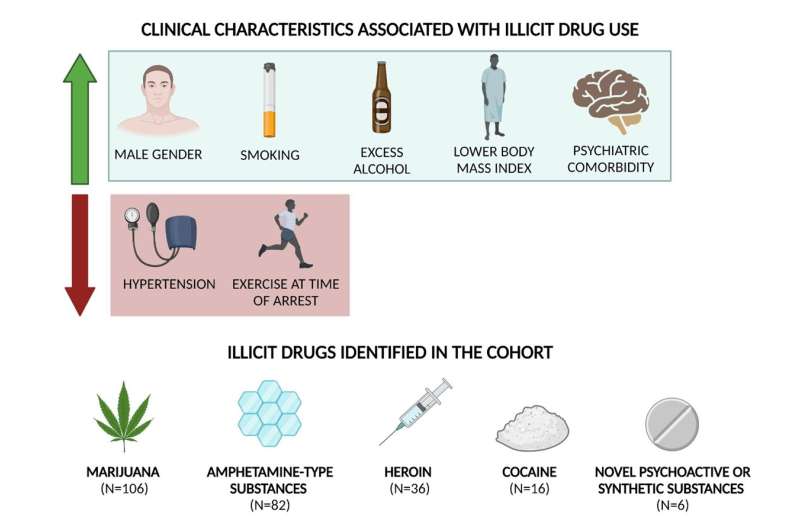This article has been reviewed according to Science X's editorial process and policies. Editors have highlighted the following attributes while ensuring the content's credibility:
fact-checked
trusted source
proofread
Illicit drug use is involved in nearly one in three sudden cardiac deaths in young adults

Approximately one-third of young adults in Victoria, Australia, who experienced sudden cardiac deaths (SCDs) outside of a hospital setting from April 2019 to April 2021 used illegal drugs prior to their fatal events, reports a new study in Heart Rhythm.
The analysis of data on substance abuse, revealed through positive toxicology reports and patient histories and recorded in one of the world's largest and most comprehensive SCD registries, shows higher levels of illicit drugs than is typical for that population, as well as a greater prevalence of multiple substance use.
The investigators analyzed data from a statewide registry on patients aged 18–50 years who experienced out-of-hospital SCD between April 2019 and April 2021 in Victoria, Australia (population 6.5 million). Toxicology assessment results were available for nearly all patients, 32.5% of which were positive for drug use. Previous estimates of drug use in Australia had ranged from approximately 16% overall to 19% for those aged 14-49.
Lead investigator Elizabeth D. Paratz, MBBS, Ph.D., FRACP, Baker Heart and Diabetes Institute, noted, "As clinicians in Melbourne, we frequently see complications of illicit drug use in young people. We noticed a consistent trend of illicit drugs involved in our registry's young SCD cohort and were very keen to tease this out further. We found the prevalence of illicit drug use in young SCD patients was astonishingly high at almost one in three cases and exceeds reported rates in the young population.
The study focused on patients for whom a cardiovascular cause of death was identified and does not include those who died suddenly of illicit drug overdoses, i.e., the illicit drugs were thought to be incidental. These patients were more likely to be male, smokers, and excessive alcohol drinkers, and had a psychiatric diagnosis, lower body mass index, and lower rates of hypertension.
Their deaths commonly occurred while they were sedentary or sleeping. While cannabis was the most common illicit drug identified, others included cocaine, amphetamines, heroin, and novel/psychoactive substances; more than one substance was frequently involved.
Dr. Paratz commented, "We were surprised by the very high rates of illicit drugs prevalent in the toxicological results of this group as compared to the overall population. Our findings raise the question: Is substance abuse underestimated or does it lead to a higher rate of cardiovascular pathology that results in SCD? We know that some young people may have a genetic predisposition for sudden death or developing coronary disease, but drug use may interact with this tendency to accelerate poor outcomes."
An editorial accompanying the study by Kristina H. Haugaa, MD, Ph.D., and Anna I. Castrini, MD, ProCardio Center for Innovation, Department of Cardiology, Oslo University Hospital, Rikshospitalet, and University of Oslo, contextualizes the findings in terms of the need to better understand how drug use contributes to cardiac disease in adults under 50—which is critical since it is potentially a reversible risk factor.
Dr. Haugaa and Dr. Castrini explained, "Illicit drugs have well known acute and chronic effects on the cardiovascular system and can act as arrhythmic triggers. Amphetamine and cocaine activate the sympathetic system and induce tachycardia and vasoconstriction, resulting in ischemia and potentially myocardial infarct."
"These drugs can trigger SCD in younger patients with predisposing diseases including congenital or inherited cardiac diseases, premature coronary disease, and myocarditis. However, still up to 30% of deaths remain unexplained after autopsy. Even when the predisposing disease has been identified, we are often left with a major question about which transient event triggered the cardiac death."
SCDs represent 50% of all cardiovascular deaths and occur unexpectedly in people without prior history of cardiac disease or a known predisposition for it.
Dr. Haugaa added, "We believe that the paper from Trytell et al. will enlighten further research on the topic. The study underlines the importance of requiring autopsy and toxicology analysis, especially in young individuals, and may help to explain some of the unexplained."
More information: Adam Trytell et al, Prevalence of illicit drug use in young patients with sudden cardiac death, Heart Rhythm (2023). DOI: 10.1016/j.hrthm.2023.06.004
Kristina H. Haugaa et al, Sudden cardiac death in the young—Can illicit drug use explain the unexplained?, Heart Rhythm (2023). DOI: 10.1016/j.hrthm.2023.06.014


















